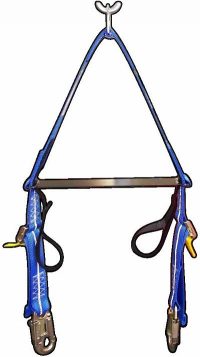In the world of material handling, efficiency and safety are paramount. The use of specialized equipment can significantly enhance these aspects, ensuring that operations run smoothly and without incident. One such piece of equipment is the spreader bar, a tool that has become indispensable in various industries for its ability to distribute weight effectively and securely. As we delve into the ultimate guide to spreader bars, you'll discover how they contribute to boosting both efficiency and safety in material handling.
Spreader bars are not just tools; they are solutions designed to meet the challenges of lifting and transporting heavy loads. They play a crucial role in preventing damage to goods and protecting workers from potential hazards. By understanding the different types and applications of spreader bars, businesses can make informed decisions that lead to optimized workflows and safer environments. This guide will explore the various aspects of spreader bars, highlighting their importance and versatility across different sectors.
Understanding Spreader Bars
When it comes to immobilizing or stabilizing objects during transport, spreader bars serve as essential tools. For instance, when applied to the ankles or between the knees, they effectively prevent awkward walking, keeping legs spread apart. This application ensures stability and control, which is vital in scenarios where precise positioning is necessary. The functionality of spreader bars extends beyond simple stabilization, offering diverse applications across multiple fields.
The concept of spreader bars is widely recognized in professional settings like rigging and installation. The ArenaMatch AMAPSPRD array spreader bar exemplifies this by providing alternate attachment points to position arrays accurately in final installation locations. Its design caters to specific needs, enhancing the precision required for complex installations. Understanding these specialized uses highlights the adaptability of spreader bars in meeting unique operational demands.
From immobilization to positioning, spreader bars demonstrate remarkable versatility. Their ability to adjust and accommodate various requirements makes them invaluable assets in numerous industries. Whether used for securing cargo or maintaining structural integrity, spreader bars consistently deliver reliable performance, ensuring that tasks are executed with minimal risk and maximum efficiency.
Applications in Cargo Handling
In cargo handling, the challenge often lies in maintaining the structural integrity of vehicles carrying heavy loads. The NRS Lower Cat Rail Spreader Bar addresses this issue by preventing the lower side rails from bowing under pressure, thus keeping the cargo floor taut. This prevents sagging and ensures that the load remains evenly distributed, reducing the likelihood of accidents or damage. Such applications underscore the critical role of spreader bars in preserving vehicle stability during transportation.
Beyond basic support, spreader bars offer enhanced control over restraint systems. The Edge Adjustable Spreader Bar exemplifies this by extending from 28.5 to 37, providing flexibility in how loads are managed. Crafted from durable materials, this bar features index lines that facilitate quick adjustments, allowing operators to fine-tune positioning with ease. The combination of durability and adjustability makes it an ideal choice for environments where precision and reliability are paramount.
For industries requiring robust solutions, the WestFall Pro 7475 Spreader Bar stands out with its dual-action, auto-locking mechanism. Constructed from heat-treated alloy steel, it boasts impressive dimensions and a secure gate system. These features ensure that the spreader bar can handle demanding conditions while maintaining optimal performance. Such innovations reflect the ongoing evolution of spreader bar technology to meet modern industrial needs.
Material and Performance Considerations
Material selection plays a crucial role in determining the effectiveness of spreader bars. Carbon fiber hammock spreader bars, for example, offer lightweight yet sturdy options suitable for recreational and commercial purposes. Available in two-piece head bars and three-piece configurations, these bars cater to varying weight capacities and usage scenarios. The emphasis on lightweight materials enhances portability without compromising strength, making them popular choices among users.
Similarly, the Lifting Equipment Store USA offers high-performance spreader bars tailored for heavy-duty applications. Designed to distribute the weight of bulky loads efficiently, these bars are constructed using advanced materials that withstand rigorous conditions. Their primary function in heavy lifting and rigging underscores the importance of selecting appropriate materials to achieve desired outcomes. By prioritizing material quality, businesses can ensure long-term durability and reliability.
In summary, the choice of material directly impacts the performance and longevity of spreader bars. Whether opting for carbon fiber or alloy steel, understanding the specific requirements of each application helps in making informed decisions. This knowledge empowers businesses to invest in solutions that align with their operational goals, ultimately enhancing overall efficiency and safety standards.

